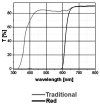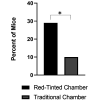Physiologic and Behavioral Effects in Mice Anesthetized with Isoflurane in a Red-tinted or a Traditional Translucent Chamber
- PMID: 35840316
- PMCID: PMC9674017
- DOI: 10.30802/AALAS-JAALAS-22-000011
Physiologic and Behavioral Effects in Mice Anesthetized with Isoflurane in a Red-tinted or a Traditional Translucent Chamber
Abstract
Isoflurane has been characterized as a distressing agent for rodents, causing both physiologic and behavioral effects. Using a "darkened home cage" has been recommended during CO₂ administration for rodent euthanasia; this is arguably a similar animal experience to anesthetic induction with isoflurane. Based on the premise that rodents perceive red light as darkness via the primary optic tract, we compared physiologic and behavioral markers of stress in 2 inbred strains of mice (C57BL/6J and BALB/cJ) anesthetized with isoflurane in either a red-tinted (dark) induction chamber or a traditional translucent induction chamber. Physiologic stress was assessed based on plasma levels of norepinephrine, epinephrine, and corticosterone. Stress-related behaviors (rearing, face wiping, and jumping) were recorded on video and scored from initiation of induction to loss of consciousness. No significant correlations were found between chamber type and physiologic stress hormones. As compared with the translucent chamber, stress-related behaviors were more frequent in the red-tinted chamber, including: 1) significantly higher rearing frequencies in BALB/cJ mice; 2) higher behavioral stress scores in BALB/cJ and male C57BL/6J mice; and 3) more face wiping behavior when considering all mice combined. These findings suggest that mice do not experience significant alleviation of physiologic indices of stress when anesthetized in a red-tinted induction chamber. Furthermore, isoflurane induction in the red-tinted chamber appeared to increase the expression of stress-related behaviors, particularly in BALB/cJ mice. Based on our findings and a growing body of literature on the unintended effects of red light, we do not recommend using red-tinted chambers for induction of anesthesia in mice.
Figures








Similar articles
-
Effect of Home Cage Bedding in the Induction Chamber on Serum Cortisol and Corticosterone Levels in Response to Isoflurane-induced Anesthesia in C57BL/6J Mice.J Am Assoc Lab Anim Sci. 2017 Mar 1;56(2):118-121. J Am Assoc Lab Anim Sci. 2017. PMID: 28315639 Free PMC article.
-
Wellbeing of Mice Euthanized with Carbon Dioxide in Their Home Cage as Compared with an Induction Chamber.J Am Assoc Lab Anim Sci. 2021 Jan 1;60(1):72-76. doi: 10.30802/AALAS-JAALAS-20-000055. Epub 2020 Oct 6. J Am Assoc Lab Anim Sci. 2021. PMID: 33023720 Free PMC article.
-
Sedation or inhalant anesthesia before euthanasia with CO2 does not reduce behavioral or physiologic signs of pain and stress in mice.J Am Assoc Lab Anim Sci. 2012 Jan;51(1):50-7. J Am Assoc Lab Anim Sci. 2012. PMID: 22330868 Free PMC article.
-
Euthanasia of laboratory mice: Are isoflurane and sevoflurane real alternatives to carbon dioxide?PLoS One. 2018 Sep 10;13(9):e0203793. doi: 10.1371/journal.pone.0203793. eCollection 2018. PLoS One. 2018. PMID: 30199551 Free PMC article.
-
The effect of light level, CO2 flow rate, and anesthesia on the stress response of mice during CO2 euthanasia.Lab Anim (NY). 2016 Sep 21;45(10):386-95. doi: 10.1038/laban.1117. Lab Anim (NY). 2016. PMID: 27654690
Cited by
-
Laboratory and physiological aspects of substitute metazoan models for in vivo pharmacotoxicological analysis.Naunyn Schmiedebergs Arch Pharmacol. 2025 Feb;398(2):1315-1339. doi: 10.1007/s00210-024-03437-5. Epub 2024 Sep 19. Naunyn Schmiedebergs Arch Pharmacol. 2025. PMID: 39298017 Review.
-
Guidelines for sex-specific considerations to improve rigor in renal research and how we got there.Am J Physiol Renal Physiol. 2025 Feb 1;328(2):F204-F217. doi: 10.1152/ajprenal.00136.2024. Epub 2024 Dec 20. Am J Physiol Renal Physiol. 2025. PMID: 39705719 Free PMC article. Review.
References
-
- Altholtz LY, Fowler KA, Badura LL, Kovacs MS. 2006. Comparison of the stress response in rats to repeated isoflurane or CO2:O2 anesthesia used for restraint during serial blood collection via the jugular vein. J Am Assoc Lab Anim Sci 45:17–22. - PubMed
-
- Bailey KR, Crawley JN. 2009. Chapter 5: Anxiety-Related Behaviors in Mice. In: Buccafusco JJ, editor. Methods of Behavior Analysis in Neuroscience. 2nd edition. Boca Raton (FL): CRC Press/Taylor & Francis.
Publication types
MeSH terms
Substances
LinkOut - more resources
Full Text Sources
Research Materials

